随着绿色储能和柔性电子纺织品的快速发展,提升水系锌离子电池的安全性与循环性能成为科研领域的热点难题。近日,浙江理工大学纺织科学与工程学院(国际丝绸学院)胡毅教授团队在国际知名期刊《Energy Storage Materials》(影响因子20.2)在线发表了题为《A Bioinspired Flexible Hydrogel Electrolyte with β-Sheet–Directed Interphase for Dendrite-Free Zn Metal Batteries》的研究论文。本研究立足纺织染整领域优势,创新引入天然丝素蛋白作为结构调控介质,结合其在柔性可加工性、构象可控性和界面亲和性等方面的独特特性,通过乙醇诱导其构象转变,构建出具有高度有序β-折叠结构的仿生界面层。这一界面层在锌金属负极表面有效抑制锌枝晶生长,显著提升电池循环寿命与安全性能。该研究不仅拓展了丝素蛋白在柔性储能器件中的高值应用路径,也为纺织基础材料向多功能智能化拓展提供了新的思路,有望为绿色可穿戴电子产品提供更高安全性、更长使用寿命的储能解决方案。论文DOI: 10.1016/j.ensm.2025.104464。本文第一作者为浙江理工大学纺织科学与工程学院硕博连读研究生申盼盼,通讯作者为浙江理工大学博士生导师胡毅教授。
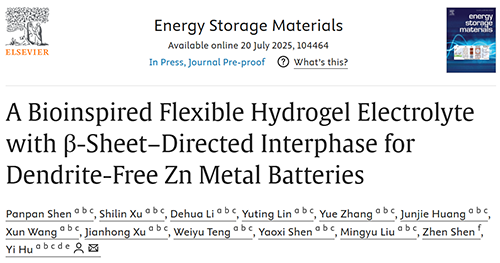
在水系锌离子电池快速发展的背景下,锌负极的枝晶生长与副反应问题成为制约电池寿命与安全性的核心瓶颈。传统电解液添加剂虽然能够在一定程度上调控锌离子的沉积行为,但多为小分子结构,难以实现界面层的高稳定性和有序功能协同。
鉴于此,浙江理工大学纺织科学与工程学院(国际丝绸学院)博士生导师胡毅教授课题组,充分发挥天然蛋白纤维、结构染整方面的学科优势,创新提出基于丝素蛋白构象诱导的仿生界面调控策略。团队以蚕茧来源的天然丝素蛋白为功能调控单元,依托其可调构象特性与优异界面亲和性,通过微量乙醇诱导丝素蛋白构象转变,由无规卷曲/α-螺旋转化为高度有序的β-折叠结构,构筑致密稳定的氢键网络,在锌负极表面形成具有力学稳定性与离子选择性的仿生保护层。得益于该仿生界面的构建,Zn||Zn对称电池实现了超过2500小时的稳定循环。基于该体系构建的Zn||MnO2全电池循环1500次后仍保持93.8%的容量,柔性锌离子纤维电池在连续2500次循环后容量保持率超过95%。本研究不仅实现了对锌沉积过程的分子层级精准调控,更探索出丝素蛋白在新能源器件界面构建中的高值应用路径,充分体现了纺织染整材料在绿色柔性储能领域的跨界融合潜力,为构建新一代安全、环保、高性能的柔性电子纺织储能单元提供了可持续发展思路。
图1.丝素蛋白的构象转变机理
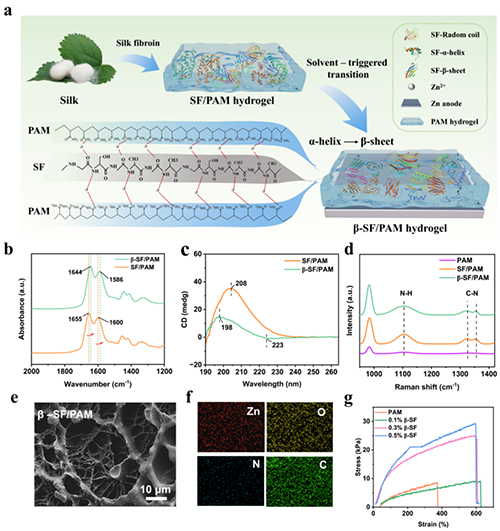
Figure 1. Conformational Transition of Silk Fibroin in PAM Gel Electrolyte. (a) Schematic illustration of solvent-induced conformational transitions in silk fibroin proteins; (b) Fourier transform infrared (FTIR) spectra of SF/PAM and β-SF/PAM gel electrolytes in the 1200–2000 cm?1 region; (c) Circular dichroism (CD) spectra of SF/PAM and β-SF/PAM gel electrolytes; (d) Raman spectra of PAM, SF/PAM, and β-SF/PAM gel electrolytes; (e) SEM images of β-SF/PAM gel electrolyte microstructure; (f) corresponding energy-dispersive X-ray spectroscopy (EDS) elemental mappings of Zn, O, N, and C within the β-SF/PAM gel; (g) tensile stress–strain curves of gel electrolytes with varying β-SF contents.
通过微量乙醇诱导丝素蛋白由无规卷曲/α-螺旋向高度有序的β-折叠结构转变,构建致密稳定的氢键网络,在锌负极表面形成具有力学稳定性与离子选择性的仿生保护层。
图2.β-SF调控Zn2+溶剂化结构与迁移行为的机制分析

Figure 2. Mechanistic investigation of β-SF regulation on Zn2+ solvation structure and migration behavior. (a) Ionic conductivity of PAM, SF/PAM, and β-SF/PAM gel electrolytes; (b) Ionic mobility number of β-SF/PAM gel electrolytes; (c) Optimized models used in DFT calculations illustrating binding energies between Zn2+ and H2O, PAM, and SF molecules; (d) Raman spectra of PAM, SF/PAM, and β-SF/PAM gel electrolytes; (e, f) Molecular dynamics (MD) simulation snapshots and representative Zn2+ solvation structures in β-SF/PAM gel electrolytes; (g、h) Radial distribution functions (RDFs) and coordination numbers for Zn2+–O (H2O), Zn2+–O (SO42?), and Zn2+–O (PAM) interactions; (i) Mean square displacement (MSD) curves of Zn2+ ions in PAM and β-SF/PAM gel electrolytes.
实验表明,β-SF/PAM水凝胶电解质在锌离子的迁移行为与界面稳定性方面表现出显著优势。该凝胶电解质体系在常温下展现出高达32.4 mS·cm-1的离子电导率和0.80的Zn2+迁移数。多种表征与理论计算表明,该仿生电解质构建了稳定高效的离子传输通道,从而赋予优异的循环性能。
图3.锌负极的界面循环性能和可逆性
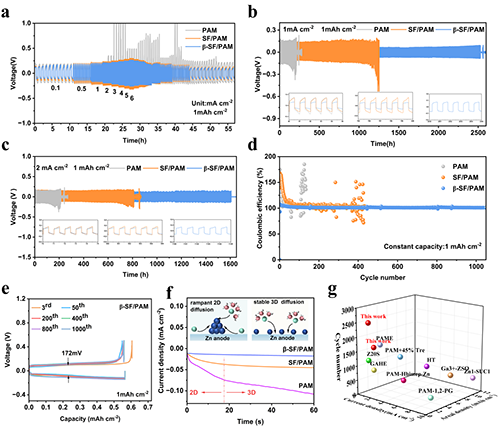
Fig. 3. Interfacial cycling performance and reversibility of zinc anode electrodes. symmetric cells with PAM, SF/PAM, and β-SF/PAM gel electrolytes at (a) rate capability at different current densities from 0.1 to 6 mA cm?2 with a fixed capacity of 1 mAh cm?2 as well as long cycling performance at (b) 1 mA cm ?2/1 mAh cm?2, (c) long cycle performance at 2 mA cm?2/1 mAh cm?2. (d) Galvanic and stripping Coulombic efficiency (CE) of Zn//PAM//Cu, Zn//SF/PAM//Cu and Zn//β-SF/PAM//Cu half-cells at 1 mAh cm?2 and (e) the corresponding charging/discharging curves of Zn//β-SF/PAM//Cu half-cells. (f) Corresponding CA curve of Zn//Zn cell at constant overpotential of ?150 mV (g) Comparison between β-SF/PAM and other hydrogel electrolytes at different parameters.
测试表明,β-SF/PAM凝胶电解质显著提升了锌负极的循环稳定性与可逆性。
图4.电极/电解质界面Zn沉积行为
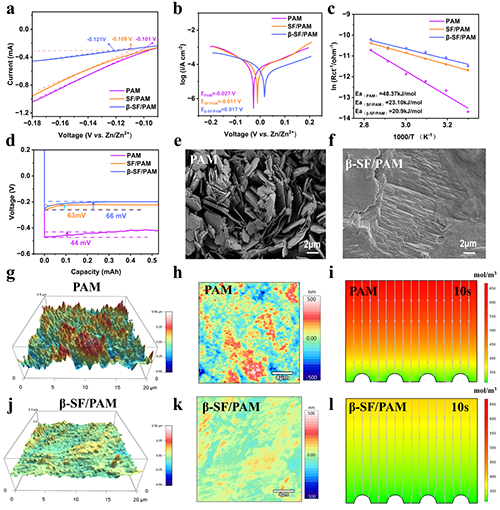
Figure 4. electrode/electrolyte interface Zn deposition behavior. PAM, SF/PAM and β-SF/PAM gel electrolytes (a) Linear sweep voltammetry (LSV) curves measured at 5.0 mV s?1; (b) Tafel curves; (c) Arrhenius curves; (d) Nucleation overpotentials; (e, f) Use of PAM and β-SF/PAM in Zn‖ Zn symmetric cells gel electrolytes after 50h cycling at 1mA cm?2; (g) Atomic force microscopy (AFM) 3D topography of Zn anode post 50 h cycling (1 mA cm?2/1 mAh cm?2) in PAM electrolyte; (h) Corresponding 2D plan view; (i) Finite element method (FEM) simulation depicting zinc ion concentration distribution in PAM electrolyte; (j) AFM 3D topography of Zn anode after 50 h cycling with β-SF/PAM electrolyte under identical conditions; (k) Corresponding 2D plan view; (l) FEM simulation showing zinc ion concentration distribution in β-SF/PAM electrolyte.
研究表明,β-折叠丝素蛋白构建的仿生界面层在抑制水系副反应与锌枝晶形成方面发挥关键作用。该体系显著提升析氢起始电位与腐蚀电位,有效缓解水分解和自腐蚀行为。
图5.β-SF调控锌负极界面机制
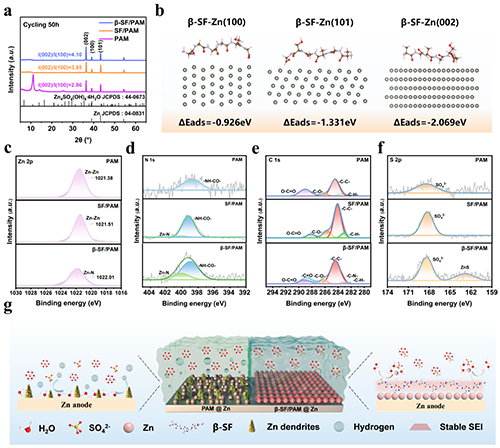
Fig. 5. β-SF modulates the interfacial mechanism of Zn anode. (a) XRD patterns of Zn anode electrodes of PAM, SF/PAM and β-SF/PAM gel electrolytes of Zn//Zn cells after 50 h cycling at 1 mA cm?2; (b) adsorption models of β-SF molecules on the surface of Zn (100), (101), and (002) and corresponding adsorption energies; XPS spectra of PAM @ Zn, SF/PAM @ Zn and β-SF/PAM @Zn anode XPS spectra of (c) Zn 2p; (d) N1s; (e) C1s; (f) S 2p; (g) Mechanism of action diagrams of PAM and β-SF/PAM electrolytes
进一步研究发现,β-折叠丝素蛋白在锌负极表面构建致密稳定的仿生界面层,有效诱导Zn2+沿低能(002)晶面择优沉积,显著抑制枝晶生成。
图6.全电池的性能及其应用
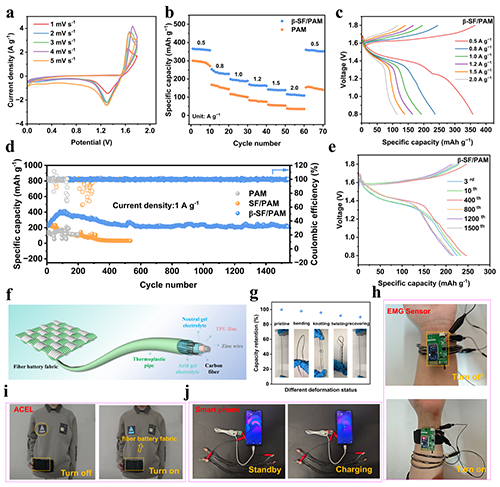
Fig 6. Demonstration of full cell performance and applications. (a) CV curves of Zn‖β-SF/PAM‖MnO2 full cells at various scan rates (1, 2, 3, 4, and 5 mV s?1) in the range of 0 to 1.8 V; (b, c) multiplicity performance and charge/discharge curves of Zn‖β-SF/PAM‖MnO2 full cells at different current densities; (d) different electrolyte systems for the Cycling performance of Zn||MnO2 full cells at 1 A g?1 and (e) Charge-discharge curves of Zn‖β-SF/PAM‖MnO2 full cells under specified cycles. (f) Schematic structure of the Zn‖β-SF/PAM‖MnO2 fiber full cell; (g) Capacity retention of the Zn‖β-SF/PAM‖MnO2 fiber cell under deformations such as twisting, winding, and knotting; (h) The fiber cell supplies power to the electromyography sensing (EMG) module, and it monitors the human body''''s vital features in real time and transmits the data wirelessly; (i) The flexible fiber battery fabric powers an ACEL flexible light-emitting module with emergency response capabilities; (j) the fiber battery charges a smartphone.
在实际应用评估中,构建的Zn‖MnO2全电池表现出优异的倍率性能与循环稳定性,1500次循环后容量保持率达93.8%。进一步构建的锌离子纤维电池在弯折、打结状态下仍维持92%以上容量,具备优异柔韧性与机械稳定性。结合纺织工艺开发的集成电子织物系统实现了生命体征监测、发光警示与能量供给,展现出在智能纺织与柔性储能领域的广阔应用前景。
总而言之,本研究基于生物基丝素蛋白的分子构象调控策略,构建了一种具有优异界面稳定性与离子传输性能的β-SF/PAM凝胶电解质。该电解质不仅显著提升了Zn2+迁移效率,抑制枝晶生长与副反应,还在刚柔兼具的电解质结构中实现了良好的电化学稳定性与循环寿命。进一步应用于柔性锌离子纤维电池后,展现出优异的柔韧性与能量输出能力,成功驱动智能可穿戴系统稳定运行。该工作不仅拓展了丝素蛋白在柔性能源材料中的高值利用路径,也为绿色、高效、可纺织的一体化储能系统构建提供了全新思路与实践基础。
在此,感谢浙江省自然科学基金项目(LY21E030023)和浙江理工大学嵊州创新研究院基金项目(SYY2024C000008)的支持!
通讯作者简介:胡毅,男,博士,教授,博士生导师。浙江理工大学纺织科学与工程学院(国际丝绸学院)副院长,主要从事非水介质染整新技术和柔性电子智能纺织品研究。以第一作者或通讯作者在Advanced Functional Materials, Nano Letters, Energy Storage Materials, Nano Energy, Chemical Engineering Journal等刊物上发表SCI论文70余篇,授权和转化国家发明专利30余项。获得国家级教学成果二等奖和浙江省教学成果特等奖各1项;主持获得中国纺织工业联合会教学成果一、二、三等奖,浙江省自然科学奖三等奖和中国商业联合会科技进步奖二等奖各1项。
原文链接:https://doi.org/10.1016/j.ensm.2025.104464
- 华科大黄永安教授团队《Sci. Adv.》:仿生制造重要突破 - “界面激光剥离”精准复刻蜻蜓翅膀 2025-12-17
- 宁波材料所陈涛/路伟团队《Adv. Mater.》: 仿生变色高分子水凝胶驱动器/机器人 2025-12-10
- 中国矿大何新建/徐欢团队 AFM: 严苛环境湿气管理与智能监测用多梯度仿生结构纤维防护膜 2025-12-09
- 苏大陈倩教授团队《Mater. Today》:超声触发原位自组装药物水凝胶 - 为肝动脉灌注化疗带来新范式 2025-12-20
- 北京化工大学尹梅贞教授/管君副教授团队 AFM: 光响应肽水凝胶通过水开关调控模量用于细胞命运调节 2025-12-13
- 燕山大学焦体峰、秦志辉团队 Macromolecules: 盐析效应与原位聚合协同构筑高强韧环境耐受性导电聚合物有机水凝胶 2025-12-13
- 上海交大梁正/颜徐州/岳昕阳 JACS:一种变革性的分子肌肉固态电解质 2025-12-22
